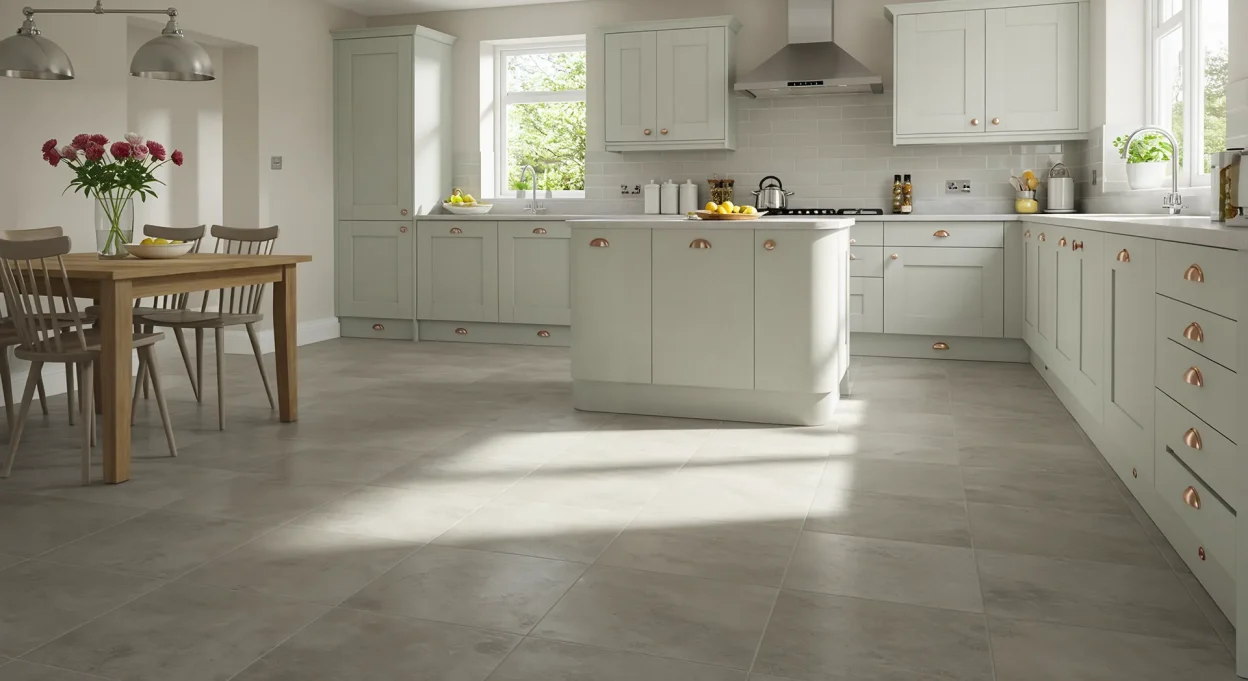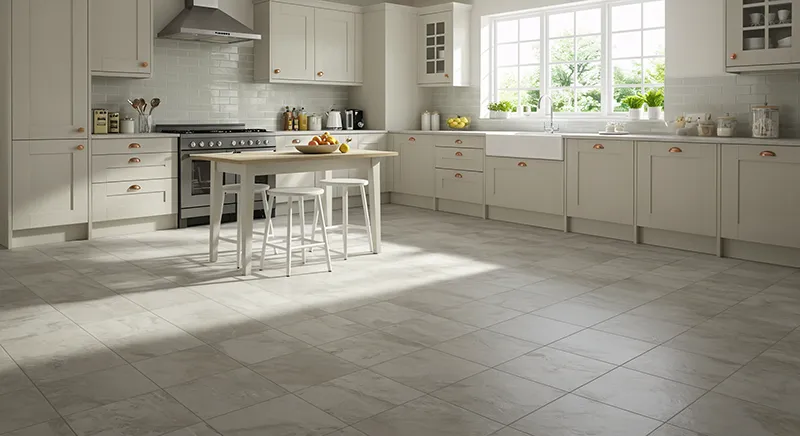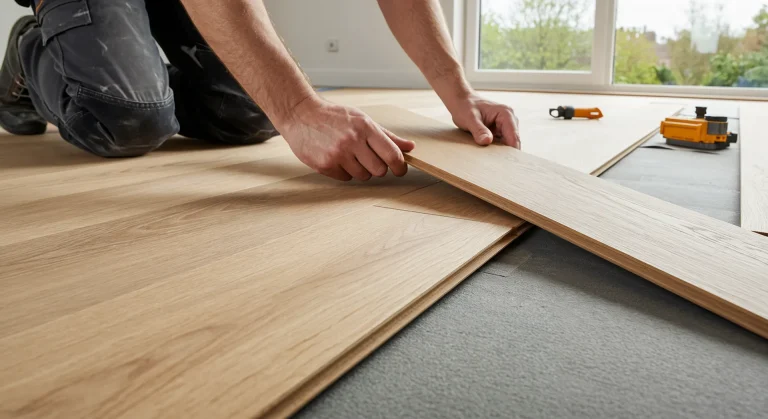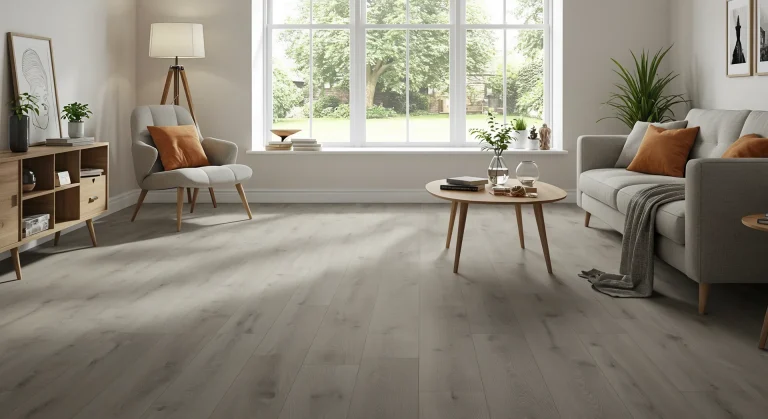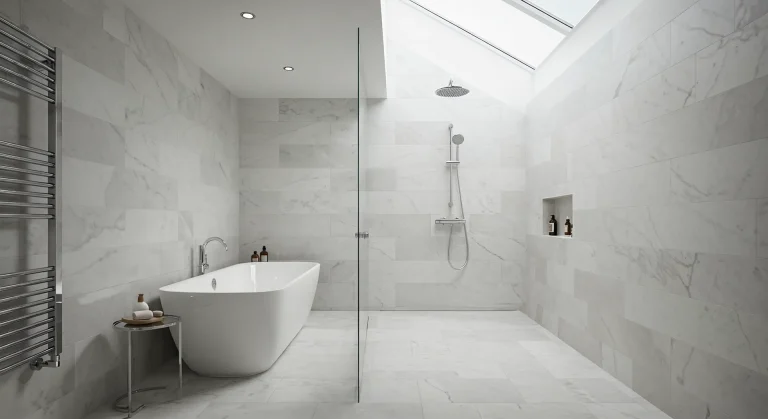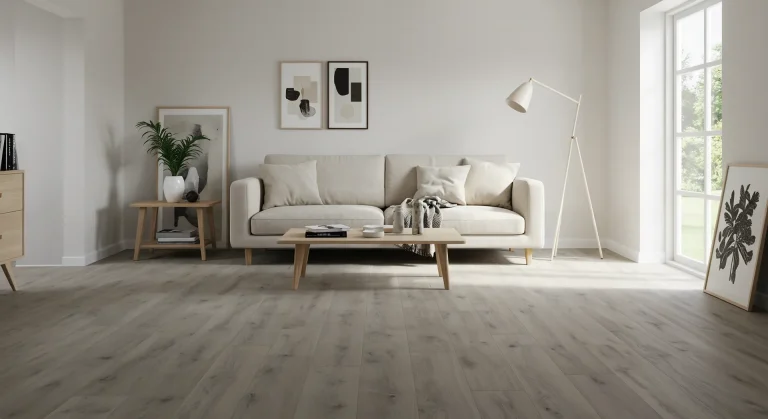Vinyl flooring has undergone a remarkable transformation. Long gone are the days of basic, easily damaged “lino” (a term often mistakenly used for vinyl). Today, vinyl floor tiles – particularly Luxury Vinyl Tiles (LVT) – represent a sophisticated, highly practical, and incredibly versatile flooring solution for UK homes. Offering stunning realism in designs that mimic natural stone, ceramic, wood, and even abstract patterns, modern vinyl floor tiles combine aesthetic appeal with exceptional performance characteristics, making them a top contender for almost any room.
But what are vinyl floor tiles exactly? How do different types like LVT and self-adhesive tiles compare? And what makes them such a popular choice in the UK for areas like kitchens, bathrooms, and busy hallways? This ultimate guide for 2025 will explore everything you need to know about vinyl floor tiles, from their construction and myriad benefits to design inspiration, installation basics, maintenance, and cost considerations, helping you choose the perfect option for your home.
Jump to Section:
- What Are Vinyl Floor Tiles? Decoding This Versatile UK Favourite
- The Big Advantages: Why Choose Vinyl Floor Tiles for Your Home?
- Luxury Vinyl Tiles (LVT) vs. Self-Adhesive: Understanding the Quality Spectrum
- Tile Styles Galore: Designs & Looks with Vinyl Floor Tiles (UK Trends 2025)
- Perfect Placements: Best Rooms for Vinyl Floor Tiles in UK Homes
- Before You Buy: Key Considerations for Your Vinyl Tile Project
- A Quick Look at Installation: Laying Vinyl Floor Tiles
- Keeping Them Flawless: Simple Care for Vinyl Floor Tiles
- Vinyl Floor Tile Costs in the UK: A 2025 Snapshot
- Vinyl Floor Tiles: The Smart & Stylish Solution for Modern UK Living?
What Are Vinyl Floor Tiles? Decoding This Versatile UK Favourite
When UK homeowners talk about vinyl floor tiles in 2025, they are most often referring to Luxury Vinyl Tiles (LVT). However, simpler, more budget-friendly options also exist:
Luxury Vinyl Tiles (LVT): This is the premium category and the main focus of modern vinyl flooring. LVT is a multi-layered product engineered for performance and realism:
- Protective Wear Layer: A transparent top coating, typically polyurethane (often enhanced with ceramic beads or aluminium oxide), providing crucial resistance to scratches, scuffs, stains, and daily wear. Its thickness (e.g., 0.3mm for light domestic use, 0.55mm for heavy domestic, 0.7mm+ for commercial) is a key indicator of durability.
- Decor/Print Layer: A high-definition photographic film that carries the design – be it realistic stone (slate, marble, travertine), ceramic tile effects, wood grain patterns (though LVT wood effects are often in plank format – LVP), or abstract/geometric designs.
- Core Layer: This provides the tile’s structure and key properties. Common types include:
– SPC (Stone Plastic Composite) Rigid Core: Extremely dense, stable, and 100% waterproof. Highly resistant to impacts and temperature fluctuations. Popular for click LVT systems.
– WPC (Wood Plastic Composite) Rigid Core: Combines wood fibres/flour with PVC and often includes foaming agents, making it slightly thicker, softer, and quieter underfoot than SPC, while still being waterproof or highly water-resistant.
– Flexible PVC Core: Used in traditional glue-down LVT, offering flexibility to conform to the subfloor. - Backing Layer: Provides foundational stability. Many rigid core click LVT products now include a pre-attached underlay (e.g., IXPE foam or cork) for added comfort and sound reduction.
Self-Adhesive Vinyl Tiles (Peel-and-Stick): These are a more basic, budget-friendly option. They typically consist of a thinner vinyl layer with a printed design and a pre-applied adhesive backing covered by a peel-off paper:
- Pros: Very inexpensive, extremely easy for DIY installation.
- Cons: Much thinner overall and a less durable wear layer than LVT, less realistic designs, the adhesive may not be as long-lasting (especially in areas with moisture or temperature changes), and subfloor imperfections will telegraph through very easily. Often seen as a temporary or low-traffic solution.
While this guide covers the concept of vinyl floor tiles generally, the focus will lean towards LVT due to its superior quality, durability, and prevalence in the current UK market.
The Big Advantages: Why Choose Vinyl Floor Tiles for Your Home?
The popularity of vinyl floor tiles, especially LVT, in UK homes is driven by a wealth of benefits:
- Superb Water Resistance/Waterproof Nature: This is a primary advantage. Most LVT, particularly SPC and WPC core products, is 100% waterproof, making it an ideal choice for kitchens, bathrooms, utility rooms, basements, and entrance halls – areas prone to spills and moisture.
- Exceptional Durability & Resilience: The tough wear layer protects against scratches, scuffs, dents, and stains, ensuring the floor can handle the demands of busy households with children and pets.
- Incredible Design Versatility: Modern printing and embossing technologies allow for stunningly realistic reproductions of natural stone (slate, marble, travertine, concrete), ceramic patterns (encaustic, geometric), and even wood effects in tile formats. The design possibilities are vast.
- Ease of Maintenance: Vinyl floor tiles are very easy to clean. Regular sweeping or vacuuming and occasional damp mopping with a pH-neutral cleaner are usually all that’s required.
- Comfort & Warmth Underfoot: Compared to real stone or ceramic tiles, LVT feels noticeably warmer and softer underfoot. WPC cores or options with built-in underlay further enhance comfort and offer good acoustic properties, reducing impact noise.
- Underfloor Heating (UFH) Compatibility: Most LVT products are designed to work efficiently with embedded UFH systems, a popular heating solution in modern UK homes.
- Installation Options: From DIY-friendly click-lock systems (common with rigid core LVT) to highly stable glue-down methods (often preferred by professionals for larger areas or intricate designs), and basic peel-and-stick for quick updates.
- Affordability: Generally more cost-effective than natural stone, ceramic tiles (especially when factoring in installation costs), or real wood.
Luxury Vinyl Tiles (LVT) vs. Self-Adhesive: Understanding the Quality Spectrum
While both are vinyl floor tiles, the difference in quality and performance is significant:
| Feature | Luxury Vinyl Tiles (LVT) | Self-Adhesive Vinyl Tiles |
| Construction | Multi-layered, robust core (SPC/WPC/PVC), thick wear layer | Thinner single or few layers, thin wear layer |
| Thickness | Typically 2.5mm – 8mm+ | Typically 1mm – 2mm |
| Wear Layer | Usually 0.3mm – 0.7mm+ (durable) | Very thin, often <0.1mm – 0.2mm (less durable) |
| Realism | Highly realistic print & often textured/embossed surface | Basic print quality, usually smooth/flat surface |
| Durability | High; resistant to scratches, dents, stains. Long lifespan. | Low to moderate; prone to scratches, dents, peeling. |
| Water Resistance | Excellent (often 100% waterproof, especially SPC/WPC) | Surface is water-resistant, but seams/adhesive vulnerable. |
| Subfloor Needs | Requires smooth, level subfloor. Rigid core more forgiving. | Requires perfectly smooth, primed subfloor. |
| Longevity | 15-25+ years with good care | 1-5 years, often seen as a temporary solution. |
| Cost (UK 2025) | Higher material cost (£20-£60+/m²) | Very low material cost (£5-£15/m²) |
For a long-lasting, high-performance floor, LVT is undoubtedly the superior choice. Self-adhesive tiles are best suited for very low-budget, temporary, or light-use applications.
Tile Styles Galore: Designs & Looks with Vinyl Floor Tiles (UK Trends 2025)
Vinyl floor tiles offer an astonishing array of design options, catering to all UK interior tastes:
- Stone & Ceramic Effects: This is where LVT truly shines in tile format.
– Slate Effect: Popular in shades of grey, black, or even multi-toned rustic effects.
– Marble Effect: Luxurious Carrara, Calacatta, or darker marble looks without the cost and maintenance of real marble.
– Travertine & Limestone Effects: Offer warm, natural stone aesthetics.
– Concrete Effect: Ideal for modern, industrial, or minimalist interiors; available in various grey tones and finishes. - Patterned Tiles: A major trend in UK interiors for 2025.
– Encaustic & Victorian Inspired: Geometric and floral patterns reminiscent of traditional Victorian tiles.
– Geometric & Abstract Designs: Modern, bold patterns to create statement floors.
– Terrazzo Effect: Small, colourful chips embedded in a base colour, offering a retro yet contemporary look. - Wood-Effect Vinyl Tiles: While planks (LVP) are more common for wood looks, LVT tiles can offer wood effects in square or rectangular formats, sometimes used for specific parquet-style layouts or a more rustic “block” appearance.
- Colour Trends: Natural and earthy tones (beiges, warm greys, muted greens and blues) are strong, providing a versatile base. Classic monochrome (black and white checkerboards) remains timeless. Bold accent colours in patterned tiles are also popular.
- Large Format Tiles: Larger vinyl tiles (e.g., 600x600mm or 900x300mm) are increasingly popular, creating a more seamless, contemporary look with fewer visible joints, especially effective in open-plan UK kitchens and living areas.
Perfect Placements: Best Rooms for Vinyl Floor Tiles in UK Homes
Thanks to their practicality, vinyl floor tiles (especially LVT) are suitable for almost any room:
- Kitchens: A top choice due to being waterproof, stain-resistant, durable, and easy to clean. Handles spills and high traffic with ease.
- Bathrooms & Wet Rooms: 100% waterproof LVT is perfect. Warmer and softer underfoot than ceramic tiles. Ensure correct installation for watertightness.
- Hallways & Entrances: High durability and easy cleaning make them ideal for these busy thoroughfares, coping well with tracked-in dirt.
- Utility Rooms & WCs: Waterproof and practical.
- Conservatories & Sunrooms: Stable rigid core LVT (like SPC) handles temperature fluctuations well.
- Living Areas & Bedrooms: Offers a comfortable, quiet, and stylish alternative to carpet or wood, especially with realistic wood or stone effect LVT tiles and UFH.
- Basements/Cellars: Good for potentially damp below-ground areas (ensure subfloor is properly prepared and a DPM is used if needed).
Their resilience and ease of cleaning make them particularly suitable for various UK homes, including active family environments or properties in coastal areas where durability against sand and moisture is beneficial.
Before You Buy: Key Considerations for Your Vinyl Tile Project
- Room Use & Traffic: Higher traffic areas (hallways, kitchens) need LVT with a thicker wear layer (0.55mm or more). Bedrooms might be fine with 0.3mm.
- Subfloor Condition: This cannot be stressed enough. Vinyl tiles, especially thinner self-adhesive or flexible glue-down LVT, require a very smooth, level, clean, and dry subfloor. Imperfections will show through and can affect adhesion or click-lock integrity. SPC rigid core LVT is more forgiving of slight subfloor variations but still benefits from good prep.
- Underfloor Heating (UFH): Most LVT is compatible, but always check the manufacturer’s specifications for temperature limits (usually around 27°C surface temperature) and any specific underlay requirements.
- Budget: Prices for vinyl floor tiles vary enormously. Self-adhesive tiles are very cheap. LVT ranges from budget-friendly to premium (brands like Pro Tek Flooring, Karndean, Amtico, Quick-Step, Moduleo are well-regarded in the UK). Factor in costs for subfloor preparation, underlay (if needed for click LVT), adhesive (for glue-down), trims, and professional fitting if not DIYing.
- Desired Aesthetic & Realism: Get samples! Colours and textures can look different online or in-store compared to your home’s specific lighting. High-quality LVT with registered embossing offers the most realism.
A Quick Look at Installation: Laying Vinyl Floor Tiles
(Detailed guides cover specific methods, but here’s an overview):
- Subfloor Preparation: Clean, dry, level, and smooth. Prime if necessary (especially for self-adhesive or glue-down).
- Acclimatisation: Allow LVT tiles/planks to acclimatise in the room for 24-48 hours.
- Click LVT Tiles:
– Often laid as a floating floor over a thin, dense LVT-specific underlay (if not pre-attached).
– Requires a small expansion gap (typically ~5mm) around the perimeter and against fixed objects. Use spacers.
– Planks/tiles interlock. Start from a straight wall, working across the room. - Glue-Down LVT Tiles:
– Apply appropriate vinyl adhesive to the subfloor using a notched trowel.
– Carefully place tiles into the wet adhesive, ensuring good contact.
– Often rolled with a heavy floor roller after installation.
– Usually best done by professionals for a perfect finish. - Self-Adhesive Vinyl Tiles:
– Peel off the backing paper and press tiles firmly onto a clean, primed subfloor.
– Careful alignment is key as repositioning can be difficult and weaken adhesion.
Keeping Them Flawless: Simple Care for Vinyl Floor Tiles
- Regular Cleaning: Sweep or vacuum (use a hard floor setting or soft brush attachment) regularly to remove dust and grit.
- Damp Mopping: Clean as needed with a well-wrung microfibre mop and a pH-neutral cleaner specifically designed for vinyl or LVT floors. Avoid soaking the floor.
- Spill Management: Wipe up spills promptly.
- Protection: Use felt pads under furniture legs. Lift, don’t drag, heavy items. Use good quality doormats at entrances (avoid rubber-backed mats which can sometimes stain vinyl over time).
- Avoid: Abrasive cleaners, scouring pads, harsh solvents, bleach, ammonia, or oil-based soaps. Steam mops are generally not recommended by most LVT manufacturers as prolonged heat/steam can potentially affect adhesives or edge integrity over time – always check your specific product’s care guide.
Vinyl Floor Tile Costs in the UK: A 2025 Snapshot
- Self-Adhesive Vinyl Tiles: The cheapest option, often £5 – £15 per m² for materials.
- Luxury Vinyl Tiles (LVT): Material costs vary significantly based on quality, brand, wear layer, and design. Expect roughly:
– Budget LVT: £15 – £25 per m²
– Mid-Range LVT: £25 – £45 per m² (Many good quality UK brands like Pro Tek Flooring, Quick-Step, Karndean Knight Tile, Polyflor Camaro fall here).
– High-End/Premium LVT: £35 – £60+ per m² (e.g., premium Karndean ranges, Amtico). - Installation Labour (if not DIY): Around £10 – £25+ per m² for click LVT, potentially more for glue-down LVT due to subfloor prep and adhesive work.
- Additional Costs: Subfloor preparation (levelling compound, plywood), underlay (if needed), adhesive, trims, thresholds, and old floor removal.
Vinyl Floor Tiles: The Smart & Stylish Solution for Modern UK Living?
So, what are vinyl floor tiles in the context of today’s UK homes? They are a highly evolved, incredibly versatile flooring category, with Luxury Vinyl Tile (LVT) leading the charge. Offering an unparalleled combination of 100% waterproof performance (for many types), outstanding durability, an almost limitless range of stunningly realistic designs, and ease of maintenance, LVT is exceptionally well-suited to the demands of modern life.
Whether you’re renovating a busy family kitchen, creating a spa-like bathroom, designing a hard-wearing hallway, or seeking a stylish and comfortable floor for your living areas, vinyl floor tiles, particularly LVT, provide a smart, practical, and aesthetically pleasing solution. Their ability to withstand spills, scuffs, and daily wear, coupled with their compatibility with underfloor heating, makes them a favoured choice across the UK, delivering lasting value and style.

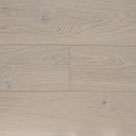 Light
Light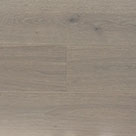 Grey
Grey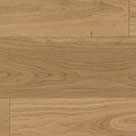 Natural
Natural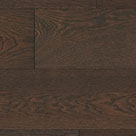 Dark
Dark White
White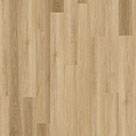 Light
Light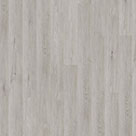 Grey
Grey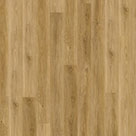 Natural
Natural Dark
Dark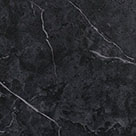 Black
Black